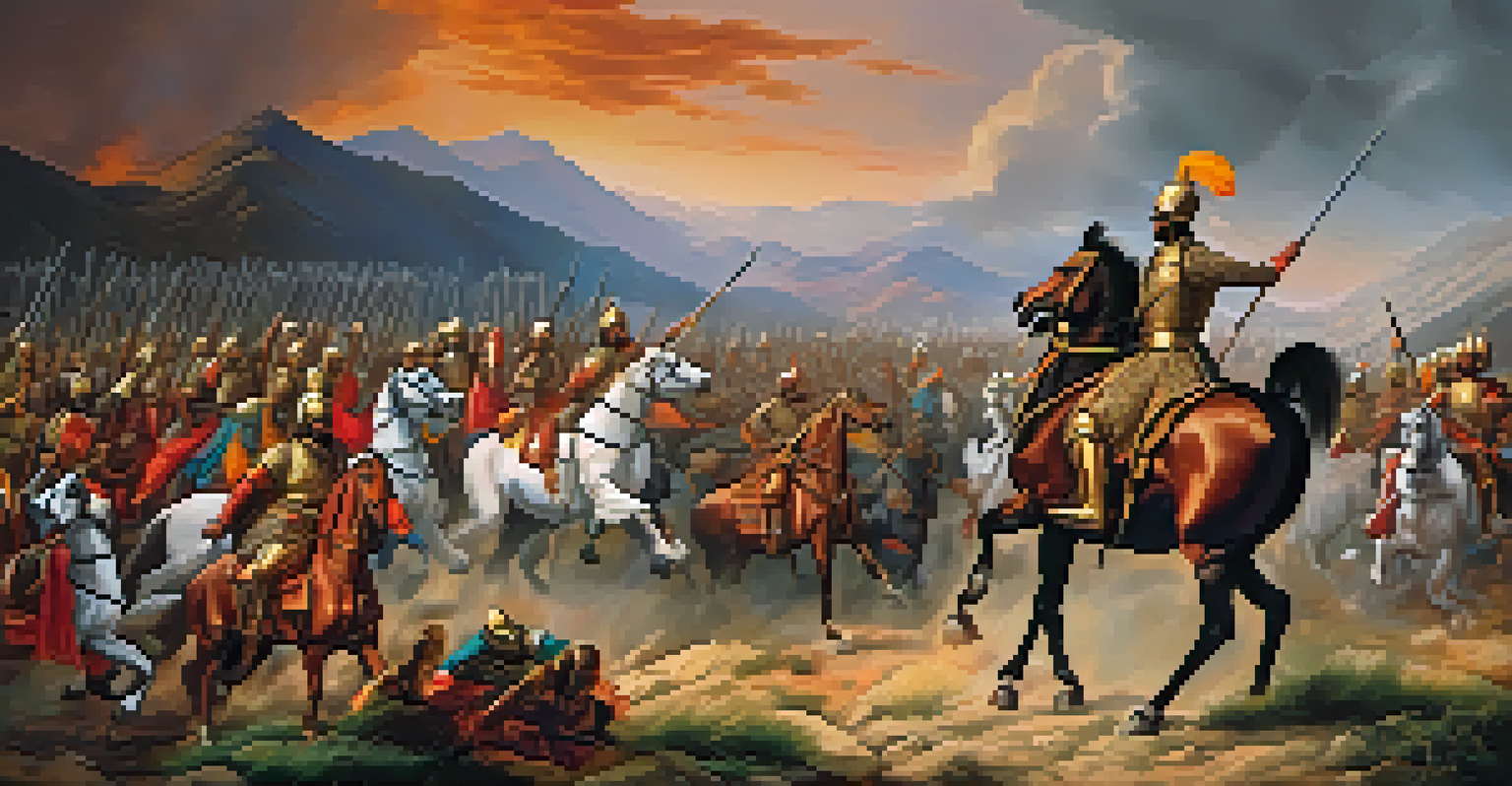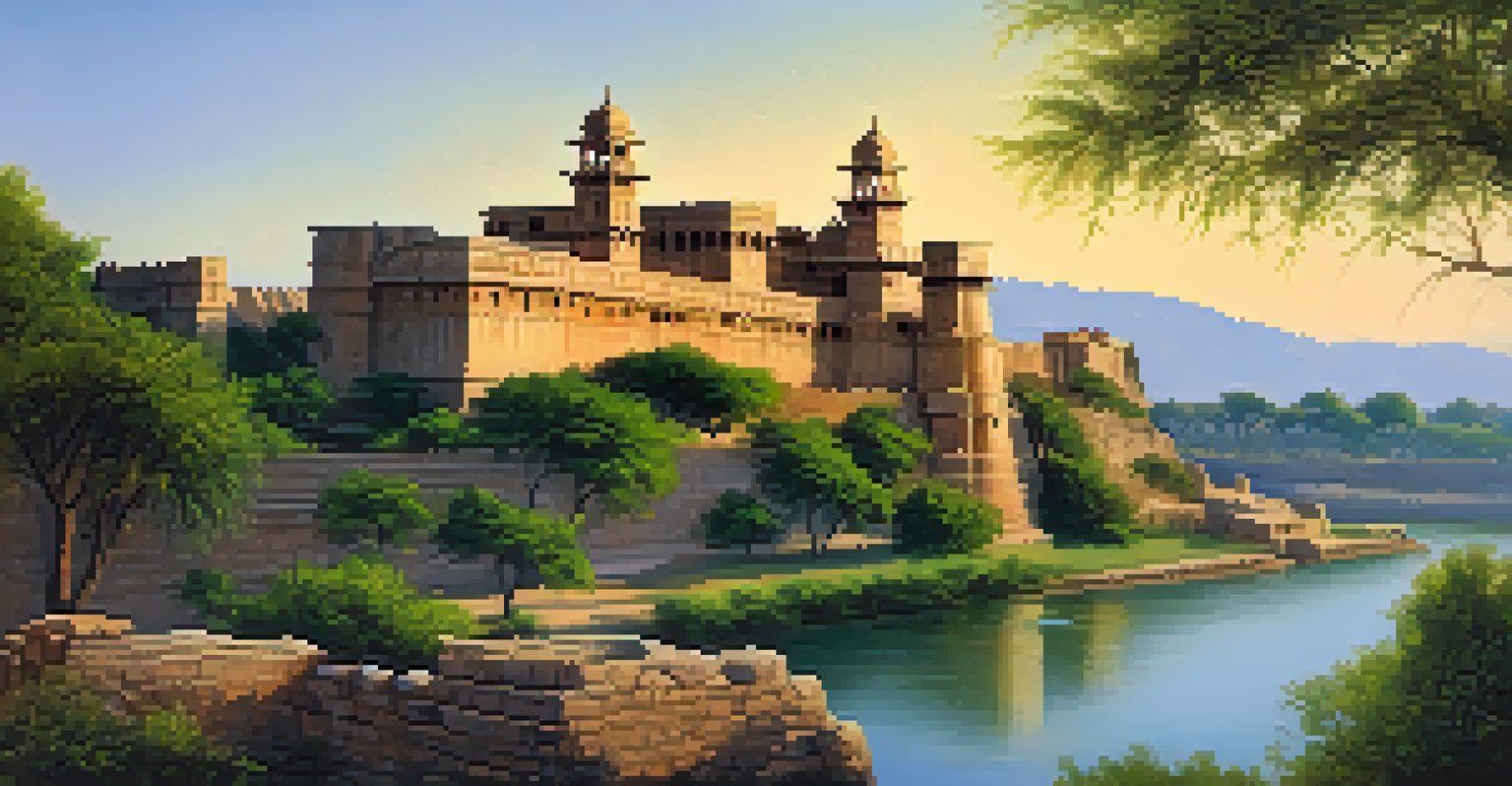A Journey Through Time: India's Famous Battlefields

The Battlefield of Panipat: A Turning Point in History
The Battle of Panipat, fought in 1526, marked the beginning of the Mughal Empire in India. This significant conflict saw Babur, the founder of the empire, clash with Ibrahim Lodi, the last Sultan of Delhi. The outcome reshaped political dynamics in the region, establishing a new era of rule that would last for centuries.
The greatest victory is that which requires no battle.
Panipat is not only known for this battle; it witnessed two more significant battles in 1556 and 1761. Each of these clashes had profound effects on the subcontinent's power structure, illustrating how one location can pivot the course of history. Visiting Panipat today, you can still feel the echoes of these monumental events.
The battlefield is now home to memorials and museums that honor those who fought. As you walk these historic grounds, you can reflect on how courage and strategy influenced the fate of a nation, making it a must-visit for history enthusiasts.
Waterloo of the East: The Battle of Haldighati
The Battle of Haldighati in 1576 is often referred to as the 'Waterloo of the East' due to its fierce and dramatic nature. This legendary conflict pitted Maharana Pratap, the valiant Rajput king, against the Mughal forces led by Raja Man Singh. Despite being outnumbered, Maharana Pratap's bravery became a symbol of resistance.

The battlefield, nestled in the Aravalli range, is surrounded by stunning landscapes, making it a poignant reminder of the spirit of Rajput valor. Today, visitors can explore the site and learn about the strategies employed during this epic showdown. The tales of bravery here resonate with anyone who appreciates resilience in the face of adversity.
Significance of Historical Battles
The battles in India, such as Panipat and Haldighati, were pivotal in shaping the political landscape and cultural identity of the nation.
Haldighati stands not just as a battlefield but as a testament to the enduring legacy of Maharana Pratap. His story inspires countless visitors, reminding us that the fight for honor and freedom is timeless.
The Siege of Chittorgarh: A Tale of Valor and Sacrifice
Chittorgarh Fort is synonymous with tales of bravery, particularly during the sieges in the 16th century. The most famous siege occurred in 1568 when the Mughal emperor Akbar aimed to conquer the fort held by Maharana Udai Singh II. The fort's defenders, including women and children, displayed unmatched courage, choosing honor over surrender.
History is written by the victors.
The fort's architecture reflects its rich history, with towering palaces and temples that tell stories of the past. Visitors can explore the ruins, which stand as silent witnesses to the sacrifices made by those who defended their home. The spirit of resistance here is palpable, offering insights into the lives of the brave souls who once walked these grounds.
Today, Chittorgarh Fort is a UNESCO World Heritage Site, attracting tourists from around the world. It serves as a reminder of India's glorious past and the lessons learned from the courage of its warriors.
Kalinga: The Battle that Changed Ashoka's Heart
The Kalinga War, fought in 261 BCE, is one of the most significant battles in Indian history. King Ashoka, who initially sought expansion through conquest, faced fierce resistance from the Kalinga kingdom. The aftermath of this brutal conflict profoundly transformed him, leading to his embrace of Buddhism and the principles of non-violence.
This battlefield is not just a site of conflict; it symbolizes a pivotal moment in the evolution of a ruler. Ashoka's remorse over the bloodshed led him to spread the message of peace and compassion throughout his empire. Today, the Ashoka Pillar stands as a reminder of this transformation, attracting pilgrims and tourists alike.
Lessons from India's Battlefields
Each battlefield reflects stories of bravery and sacrifice, teaching valuable lessons about resilience and the quest for freedom.
Visiting the site of the Kalinga War allows one to reflect on the power of change and redemption. It serves as a powerful reminder that even in times of strife, there is potential for growth and understanding.
The Great Siege of Delhi: A Fight for Independence
The Siege of Delhi in 1857 marked a monumental uprising against British colonial rule, often referred to as India's First War of Independence. The city became a battleground as Indian soldiers and civilians united against the British forces. The siege was characterized by fierce fighting and significant sacrifices on both sides.
Delhi's historical sites, including the Red Fort, serve as poignant reminders of this turbulent time. As you stroll through these landmarks, you can almost hear the echoes of the past and the voices of those who fought for their freedom. This period was not just a struggle for power but a quest for identity and independence.
Today, the remnants of the siege inspire a sense of pride and resilience among Indians. Visiting Delhi offers an opportunity to honor the legacy of those who fought bravely for their nation's freedom, reminding us of the importance of standing up for one's beliefs.
The Battle of Talikota: The Fall of the Vijayanagara Empire
The Battle of Talikota in 1565 was a decisive conflict that led to the downfall of the mighty Vijayanagara Empire. This battle, fought between the forces of the empire and a coalition of Deccan Sultanates, showcased the fierce competition for power in South India. The defeat marked a significant turning point in the region's history.
The ruins of Hampi, the empire's capital, are a UNESCO World Heritage Site that narrates the tale of its grandeur and eventual fall. As you explore the ancient temples and structures, you can feel the echoes of a once-flourishing civilization. The architecture tells stories of wealth, culture, and the impact of warfare on society.
Exploring Lesser-Known Conflicts
The lesser-known battles in regions like North-East India highlight the diverse struggles for autonomy and the rich cultural heritage of the country.
Visiting Talikota and Hampi allows travelers to connect with the rich history of the Vijayanagara Empire. It serves as a reminder of the cyclical nature of power and the lessons learned from the rise and fall of great empires.
The Battlefields of the North-East: A Forgotten Chapter
While many battlefields of India are well-known, the conflicts in the North-East remain a lesser-known chapter in history. The Anglo-Manipur War in 1891, for example, showcased the fierce resistance of the Manipuri people against British colonial forces. This battle highlighted the complexities of the region's history and the struggle for autonomy.
The landscapes of the North-East, with their lush hills and valleys, tell stories of bravery and resilience. Many sites, though not heavily visited, hold significant cultural and historical value. Exploring these battlefields offers a unique perspective on India's diverse heritage and the myriad struggles faced by its people.

Visiting these lesser-known battlefields provides an opportunity to honor the unsung heroes of India's past. It encourages a deeper understanding of the country’s history and the various narratives that have shaped its identity.
Legacy of India’s Battlefields: Lessons Learned
The battlefields of India have shaped not only its history but also its cultural identity. Each conflict tells a unique story of bravery, sacrifice, and resilience, offering valuable lessons for future generations. These sites remind us of the complexities of human nature and the consequences of conflict.
As we explore these historical sites, we are reminded of the importance of peace and understanding. The stories of those who fought are not just tales of war; they are lessons in humanity, courage, and the quest for freedom. They encourage us to reflect on our values and the legacy we leave behind.
Visiting India's battlefields today serves as a powerful reminder of the need for dialogue and reconciliation. By learning from the past, we can foster a future where peace prevails and the lessons of history guide our actions.